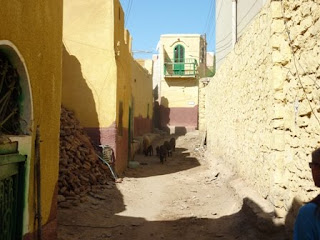
We arrived in Luxor, the “hassle capital” of Egypt…wow, we didn’t think it could get any worse! The good news is that our beautiful little hotel, El Nakhil, was located on the opposite bank of the river nestled in a palm grove.

We took the ferry across to the Luxor Temple which is right in the heart of the modern town. At sunset the temple is lit up, creating an eerie spectacle as shadow and light play off the reliefs and colonnades.

In front of the temple is the beginning of the avenue of sphinxes that ran all the way to the temples at Karnak 3km to the north. It is currently being excavated…so for 3km you find the remains of sphinxes on sidewalks, in front of shops and along the street.

The next morning our "Dahabiya-mate" Duncan joined us for a bike ride. We decided to bike around the tombs and temples. Here we are making our way up the Valley of the Kings, as quoted in Lonely Planet “the road in is a gradual, dry, hot climb…” Riding a 1960’s one-speed bike in the desert seemed like a good idea at the time. The best part was looking at the faces of all the tourists as they roared by in their air conditioned buses. Envy? I don’t think so, but hey…at least we burned a calorie or two.

Traffic also got hairy at times…..our goal was to NOT be passed by a donkey.

The Temple of Seti I, which was recently restored after being damaged by floods in 1994. In places you can still see color. It is amazing to think what these temples must have looked like brightly painted!

We had so much fun passing donkeys the first day that we decided to try it again. This is the Temple of Hatshepsut, surrounded by limestone cliffs that rise nearly 300m above the desert plain. It has also been designated as one of the hottest places on earth, perfect for an early morning bike ride. Ugh.

More vibrant color. The reliefs are incredibly detailed…Sad to say, but Lonely Planet quoted, “the secretary-general of the Supreme Council of Antiquities has stated that tourism is the greatest threat to the Egyptian monuments, and that if nothing is done they will be destroyed in less than 100 years. “

The Valley of the Queens….no cameras allowed in the tombs, thus no pictures! The tombs have suffered great damage from mass tourism: carbon dioxide, friction and humidity produced by the average of 2.8g of sweat left by each visitor. The inside of the tomb is comparable to a “steam room” and smells like a high school locker room. You move fast.

The Temples of Karnak are an extraordinary complex of sanctuaries, kiosks, pylons and obelisks dedicated to the Theban gods and the greater glory of pharaohs. The Temple of Amun is the largest religious building ever built. This is a picture of the Great Hypostyle Hall which is large enough to contain both Rome’s St. Peters Basilica and London’s St Paul’s Cathedral. The hall has a forest of 134 towering papyrus-shaped stone pillars.
 Our last day in Luxor we visited ACE (Animal Care in Egypt, www.ace-egypt.org.uk), a small UK charity dedicated to making a difference to the lives of working animals. We have been traveling for eleven months and have been to over twenty countries...and I can tell you that I have NEVER seen animal abuse like the kind we've seen in Egypt. Definitely my new charity (once I start getting a paycheck again!) On to the Red Sea for some diving!
Our last day in Luxor we visited ACE (Animal Care in Egypt, www.ace-egypt.org.uk), a small UK charity dedicated to making a difference to the lives of working animals. We have been traveling for eleven months and have been to over twenty countries...and I can tell you that I have NEVER seen animal abuse like the kind we've seen in Egypt. Definitely my new charity (once I start getting a paycheck again!) On to the Red Sea for some diving!






































